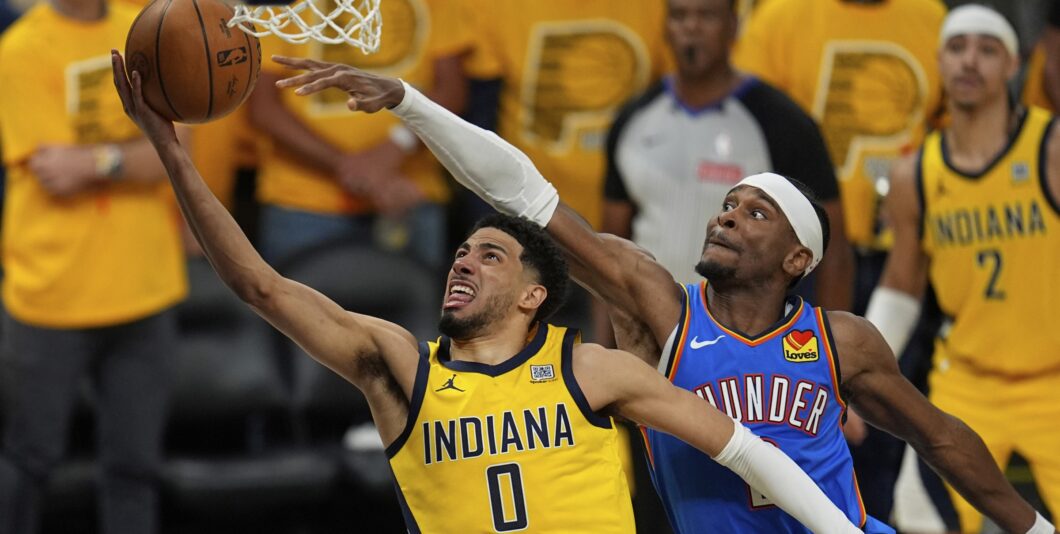Should Olympic athletes keep silent about China's outrages against the Uyghurs?
The Pacers' Model
Win or lose, the 2024-25 Indiana Pacers are something special. After an undistinguished start to the season, they were the fourth-best team in the National Basketball Association, amassing a regular season record of 34-14 since the start of the year. In the playoffs, after defeating underdog Milwaukee, they beat the odds and defeated heavily favored Cleveland and New York. As of this writing, they have taken two games from one of the teams most heavily favored to win the championship in decades, the Oklahoma City Thunder. And in so doing, they have exemplified key features of classical liberalism.
In the best sense of the word, they are an individualistic team. That doesn’t mean that every player is thinking about himself, but rather that everyone on the roster is a unique threat, and it is common for a different player to shine in each game. The players themselves bring distinctive sets of abilities to the court, and the Pacers thrive not by making each player fit into a mold but by allowing each to remain true to his identity. The team is one of the most hyperkinetic in the league, which means that each player on the floor needs to work hard the whole time. And the coaching staff, led by Rick Carlisle, encourages each player to do what he judges best in the moment, while owning his choices.
The Pacers embody many of the principles of one of the greatest coaches in any sport, fellow Hoosier John Wooden, the first person to be inducted into the basketball Hall of Fame as both a player and a coach. Wooden’s classic championship teams varied dramatically from one another, as did their winning strategies. His first championship team was also his shortest, with no players taller than 6 feet 5 inches. Yet they went 30-0 because each player knew how to “play tall,” intimidating opponents with a full-court press. Yet Wooden could also win with teams built around big men such as Lew Alcindor.
To watch the Pacers play is to behold freedom and autonomy in action. The players are unpredictable, creative, and always improvising. Instead of implementing a top-down plan, they focus on adapting moment to moment to opposing players. This often renders the game exhilarating, the ball moving up and down and around the court at breakneck speed. Offense and defense meld into one another with nearly unprecedented fluidity. Whether the players get the ball on a rebound, turnover, or score, it often reaches the opposite end of the court in just seconds.
Wooden trusted his players to exercise their judgment in the moment. Never was he seen diagramming a play on the sidelines. The winner of twice as many men’s national collegiate championships as his closest competitor—10—he delighted in challenging his much younger, fitter players to beat him in a race down the court. When they took off sprinting, Wooden would throw the ball to the opposite end, a lesson the Pacers have learned well. Likewise, when it comes to improvisation, Wooden often said that he hoped to be as surprised by what his players did on the court as the opposing coach.
The Pacers embody one of John Wooden’s favorite sayings, that the player who makes the team great is better than a great player.
The Pacers also embody equality of opportunity. It is not uncommon for more than five players to finish the game having scored in double digits, and their approach is balanced in an unusual way. They are not afraid to let a player or two shine, but the player in the limelight typically changes from game to game. There is no star that the rest of the team consistently relies on to pull them through. Each player is free to work his magic on the court on both offense and defense, and stymying opponents’ attempts to drive, stealing the ball, and blocking shots on defense is as highly prized as a hot hand.
During the regular season, seven Pacers averaged at least 10 points per game, and in the playoffs, the difficulty they present to opposing teams has been likened to a game of Whac-a-Mole. If the defense tries to key on one player, they seamlessly shift the ball to others, and when things are going well, their play resembles poetry in motion. They can drive the lane for a layup and then suddenly rocket the ball to a player on the perimeter, turning two points into three. A player who has an off night one game can come back and score 30 or more points the next.
Again, there are echoes of Wooden. During after-game press conferences, Wooden typically devoted considerably more attention to the squad’s unsung heroes than superstars such as Bill Walton. Most spectators saw what was happening only during game time, but Wooden took into account the many hours of conditioning, drills, and scrimmages that went into preparing each player to perform at his best. Wooden knew that his players had been prepared to excel, and only someone actually on the court could adapt quickly enough to the continuously evolving flow of the game.
In essence, the Pacers feel like more of a team than most NBA teams, precisely because they function more collaboratively. They embody one of Wooden’s favorite sayings, that the player who makes the team great is better than a great player. The Pacers often play 10 or 12 players per game, and their bench usually contributes far more points than their opponents’ bench. Players come and go, but the rapid flow of the Pacers’ game continues unabated, literally taking the breath away from many opposing players, who often begin to look winded well before the final buzzer sounds.
The Pacers also persevere, embodying the Churchillian directive, “Never give in. Never. Never. Never. Never.” Their tenacious defense forces opponents out of their comfort zone, and their rapid ball and player movement make it difficult for opponents to keep track of who they are supposed to be guarding. Their strong, Wooden-esque work ethic shines through as they apply full-court pressure throughout a game, ensuring that nothing comes easy for the opposing team. They stay with it right up to the end, and like Wooden’s teams, they often win in the last minutes or even seconds, after trailing most of the game.
In an Eastern Conference quarterfinals game, they rallied from a 7-point deficit in overtime to defeat the Bucks, when their odds of winning were approximately 2 percent. In game 2 of the semifinals, they staged a comeback and took the lead with only seconds to go. In an Eastern Conference finals game, they overcame a 14-point deficit to win in overtime, nearly triumphing in regulation except for the fact that a player’s foot was slightly over the three-point line. And in game 1 versus the Thunder, they rallied from a 15-point deficit to win with just 0.3 seconds on the clock. They don’t give in.
Wooden loved to say that failure is not fatal, but the failure to change might be. The Pacers are continuously changing, like a successful entrepreneur adapting to changing market conditions, except at a much faster rate. They are like the Greek mythological figure of Proteus, shifting their shape in ways that make it impossible for opponents to get a grip. The main ingredient of stardom, Wooden said, is the rest of the team, a truth that the Pacers embody to as great an extent as any team in history. They are—as any lover of freedom and responsibility cannot fail to see—liberty in motion.



